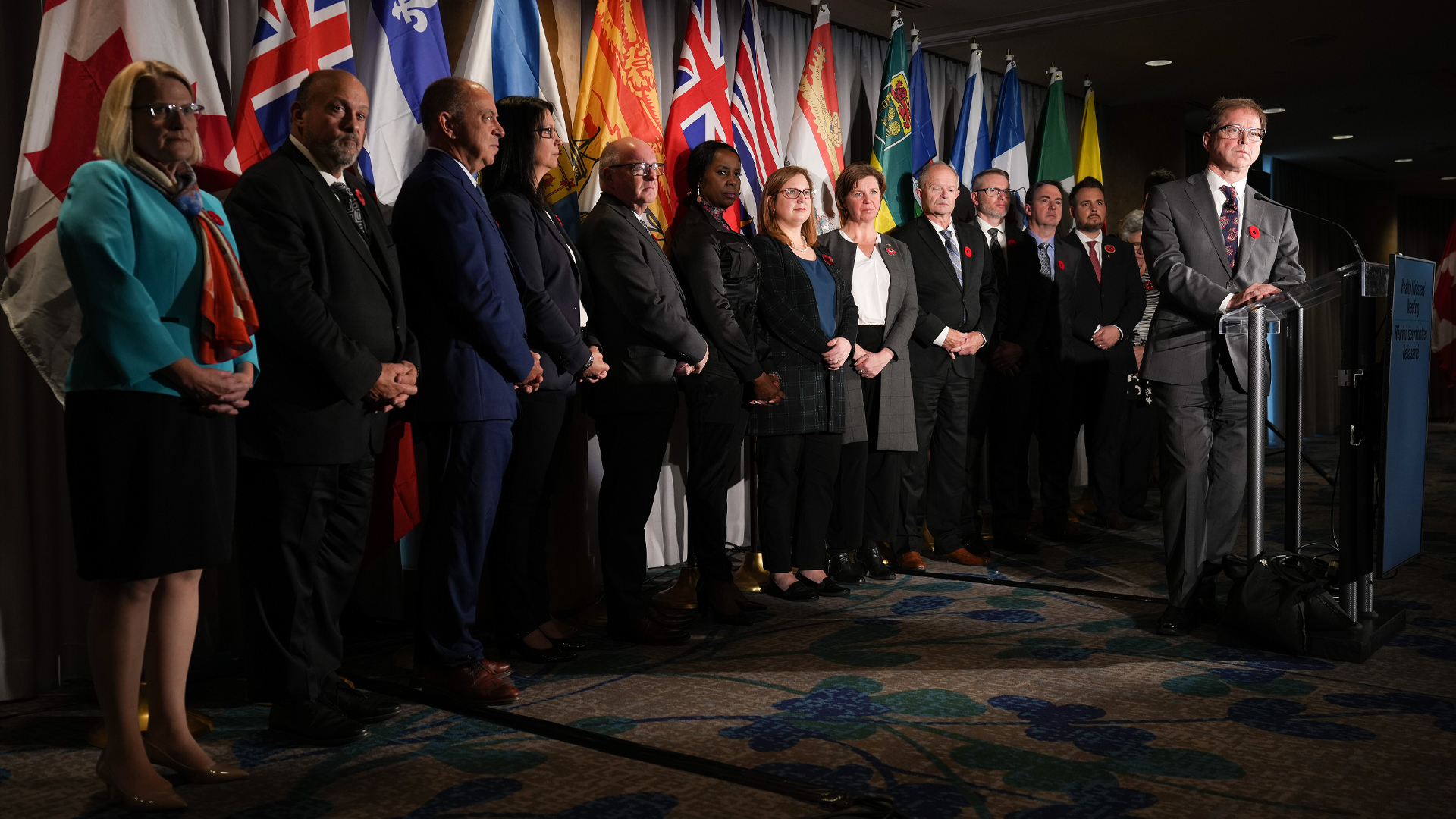
The age old question of “Whither Canada?” seems particularly apt at a time when tensions between the Government of Canada and provincial and territorial administrations appear at such a low point, made worse by an undercurrent of personal animosity. The situation cries out not only for genuine leadership but a re-examination of the machinery of intergovernmental relations. As one who toiled in that field for 30 years as a federal public servant, I can attest to the fact that what political scientist Richard Simeon called “federal-provincial diplomacy” is both necessary and often difficult and disappointing. That is the nature of a federation. Yet it does not make the work any less necessary.
November’s meeting of federal-provincial-territorial health ministers is only the most recent example of how not to do federal-provincial relations. When both sides come to serious public issues with little more than “all or nothing” bargaining positions, the context is hardly conducive to genuine negotiations. Political gamesmanship is not responsible leadership.
The personal element should not be underestimated, and it is not simply a question of partisan affiliation. During the constitutional negotiations of 1980-81, the Liberal government under then-prime minister Pierre Trudeau negotiated with provincial administrations both Conservative and New Democrat. Months of hard bargaining ensued, out of which came patriation and a Charter of Rights and Freedoms.
Resentment in the Canadian Federation
Coping with COVID requires a return to co-operative federalism
Standing up to Ottawa: Western alienation shift into Prairie constitutional challenges
Critical roles were played by premiers William Davis of Ontario, Peter Lougheed of Alberta and Allan Blakeney of Saskatchewan. Compare that to the current situation. Alberta Premier Danielle Smith and Saskatchewan Premier Scott Moe openly promote ignoring federal laws under the legally dubious and constitutionally questionable guise of provincial “sovereignty.” Ontario Premier Doug Ford appears unwilling or unable to play the kind of nation-building role in Confederation in the tradition of former premiers Davis, David Peterson and Bob Rae.
Then there is the personalization of politics, which has become a sad and offensive part of political discourse today. The issues facing Canada today require adults in the room.
Add to this the question of institutional support. After winning his first election in 2015, Prime Minister Justin Trudeau promised to make federal-provincial relations a priority, including more frequent First Ministers Meetings. Yet as the November health ministers meeting demonstrated, high-level meetings can be a high-risk exercise and serve to exacerbate rather than ease ongoing tensions.
Whether it is clashes with the Quebec government over language policy, with Western provinces over natural resource development and environmental protection, or the immense health-care challenges exposed by the global COVID-19 pandemic, the issues facing First Ministers are formidable and demand a co-ordinated response.
After years of neglecting these meetings, federal and provincial-territorial governments lack the necessary resources and expertise required to use this forum to address the issues that are part and parcel of the Canadian federal system.
First Ministers’ Meetings have no formal basis in the Constitution. Instead, their creation and development took place organically, spurred by the constitutional division of powers between the federal and subnational governments as the state expanded over time.
The first meeting took place in October 1906. Chaired by Sir Wilfrid Laurier, prime minister at the time, the meeting was held at the request of premiers to discuss the perennial issue of financial subsidies to provinces
The Great Depression, and with it the socioeconomic strain felt by member jurisdictions, spurred the frequency of First Ministers’ Meetings. This trend continued into the 1940s following the publication of the Royal Commission on Dominion-Provincial Relations (Rowell-Sirois), post-war reconstruction and the expansion of the welfare state.
The high-water mark of federal-provincial diplomacy came in the 1960s and continued through to the 1980s. It was at the February 1968 Constitutional Conference that the then-minister of justice Pierre Elliott Trudeau first leapt into public consciousness. It helped catapult him into the leadership of the Liberal Party of Canada and prime minister that summer.
The long struggle to patriate the Constitution culminated in a First Ministers’ Meeting in November 1981. Three subsequent meetings (1983, 1985 and 1987, the latter two chaired by former PM Brian Mulroney) sought unsuccessfully to come to a consensus over the meaning of Aboriginal self-government and treaty rights under Section 35 of the Constitution Act, 1982.
What became known as the Meech Lake Accord would be signed at a First Ministers’ Meeting in June 1987, only to regrettably fail following a three-year ratification process. The 1990s would see the last great focus on First Ministers’ Meetings – 11 over the decade – on issues ranging from the Constitution (the Charlottetown Accord) to the economy.
Into the 2000s, a dramatic drop off in the frequency of First Ministers’ Meetings is evident. There were only two chaired by former prime minister Jean Chrétien (in addition to the five he managed in the 1990s), one by Paul Martin, and three by former prime minister Stephen Harper.
Why was such a key element of federal-provincial negotiation seemingly abandoned? One common explanation is that in the aftermath of the failed constitutional exercise, a kind of collective exhaustion overtook intergovernmental relations. The price of failure, particularly after the “near death” of the 1995 Quebec referendum, was deemed too great to open the Pandora’s box of the Constitution again. The era of “mega-diplomacy” came to an end.
It was also during the 1990s that both federal and provincial governments, as part of cost-cutting exercises, severely curtailed or eliminated offices and personnel devoted to federal-provincial relations. At the federal level, for example, the Federal-Provincial Relations Office, once the nerve-centre of federal strategy and headed by such distinguished senior deputy ministers as Gordon Robertson and Norman Spector, was eliminated as a separate office. Its functions were dispersed within the Privy Council Office.
A similar phenomenon took place at the provincial level. Provincial government offices based in Ottawa were closed, and separate federal-provincial relations units within departments folded. Budgetary restrictions made it difficult or impossible for federal-provincial relations advisors and analysts to hold regular face-to-face meetings. During the Harper era, large-scale multilateral negotiations were abandoned in favour of bilateral meetings.
As a result, significant institutional expertise was irrevocably lost. Indeed, an entire generation of public servants would be largely unprepared to deal with the unique policy and organizational challenges of a First Ministers’ Meeting because they had no experience of one.
Years of neglect made Prime Minister Justin Trudeau’s pledge to revitalize federal-provincial relations akin to restarting a car after the engine has seized. While the promise was laudable, it was not backed by the necessary resources needed to maximize the chances of success.
The December 2018 First Ministers’ Meeting is a case in point. The agenda gave every appearance of being both drafted unilaterally and heavily weighted toward federal-only priorities. If this was the case, the pushback by provinces was hardly surprising.
Similarly, the agenda produced by the Prime Minister’s Office for the March 2020 meeting showed no evidence of having been the product of federal-provincial negotiations. Instead, well-travelled federal Liberal Party themes and language dominated.
This underscores unsophisticated and inadequate tools in support of intergovernmental negotiations. First Ministers’ Meetings are key elements in the evolution of the Canadian federal system. They should continue to be so. Organized and supported properly, they can play the kind of role the Senate was intended to play but failed to do so.
Given the remote possibility of Senate reform, a more practical solution is revising First Ministers’ Meetings. Formalize their status and equip them with the means to do the heavy lifting associated with managing the federation, similar to the German federal system, for example.
Instead of decrying “executive federalism,” the time has come to accept the necessary role of First Ministers’ Meetings and commit the resources to make them work more effectively as an instrument by which to address the increasingly complex and difficult policy challenges facing Canada.
Federal-provincial diplomacy is serious business. But if diplomacy is to succeed in reaching agreement, the tools must be there to do the job properly. The stakes are too high otherwise. Past neglect has consequences.











